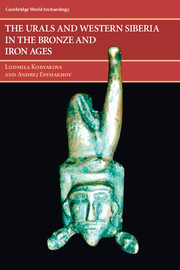Book contents
- Frontmatter
- Contents
- List of Plates, Figures, and Tables
- Foreword, by Philip L. Kohl
- Preface
- Introduction
- PART ONE THE BRONZE AGE: THE RISE OF ECONOMIC AND CULTURAL COMPLEXITY
- PART TWO THE IRON AGE – FORMING EURASIAN INTERACTIONS
- 5 The Transition to the Iron Age and New Tendencies in Economic Development
- 6 The Southern Urals within the Nomadic World: at the Cultural Crossroads
- 7 The World of Cultures of Cis-Urals Forest Zone of Eastern Europe: the Maintenance of Cultural Identities
- 8 The Forest-Steppe Cultures of the Urals and Western Siberia: on the Northern Periphery of the Nomadic World
- 9 Social Trends in North-Central Eurasia During the Second and First Millennia bc
- Notes
- References
- Index
6 - The Southern Urals within the Nomadic World: at the Cultural Crossroads
from PART TWO - THE IRON AGE – FORMING EURASIAN INTERACTIONS
Published online by Cambridge University Press: 03 February 2010
- Frontmatter
- Contents
- List of Plates, Figures, and Tables
- Foreword, by Philip L. Kohl
- Preface
- Introduction
- PART ONE THE BRONZE AGE: THE RISE OF ECONOMIC AND CULTURAL COMPLEXITY
- PART TWO THE IRON AGE – FORMING EURASIAN INTERACTIONS
- 5 The Transition to the Iron Age and New Tendencies in Economic Development
- 6 The Southern Urals within the Nomadic World: at the Cultural Crossroads
- 7 The World of Cultures of Cis-Urals Forest Zone of Eastern Europe: the Maintenance of Cultural Identities
- 8 The Forest-Steppe Cultures of the Urals and Western Siberia: on the Northern Periphery of the Nomadic World
- 9 Social Trends in North-Central Eurasia During the Second and First Millennia bc
- Notes
- References
- Index
Summary
The first millennium bc was marked by the appearance in the historical arena of new powerful actors, whose “barbarian” image was associated with constant movement, destruction, and horror. The ancient writers characterized them as extremely militant and victorious. From time to time, their groups emerged on the border of “civilizations” under different names, but always with the same look – armed, mounted warriors symbolizing a new epoch. In a relatively short time, the nomadic people adapted to the vast steppe expanse with its extreme climatic conditions and united different areas – either voluntarily or involuntarily – into one economic and cultural zone that greatly enhanced mutual intercommunication. They created the “barbarian periphery” without which the “civilized” states could no longer exist. The birth of this “Nomadic World” in Eurasia was neither easy nor welcomed, but there was no alternative. Before we discuss the Uralian nomadic cultures, we will pause to review some general points of nomadic studies.
GENERAL ASPECTS OF NOMADIC STUDIES
Ecological and Historical Dimensions of Eurasian Nomadism
Eurasian nomadism has long been the focus of attention for travelers, writers, ethnographers, historians, government officials, and military officers of tsarist Russia. Their numerous descriptions and stories are rich in valuable empirical and statistical material. Gathered from these materials, we can see that the character of extensive stockbreeding remained practically unchanged until the early twentieth century. Environments and biological specifics of bred animals, ways of transmigrations, and the forms of use of natural resources determined this nomadism.
- Type
- Chapter
- Information
- The Urals and Western Siberia in the Bronze and Iron Ages , pp. 203 - 250Publisher: Cambridge University PressPrint publication year: 2007



